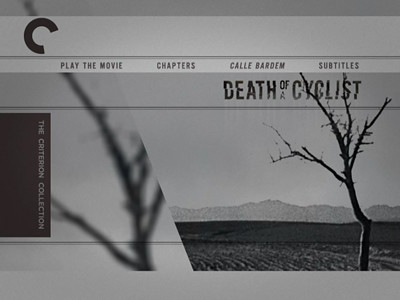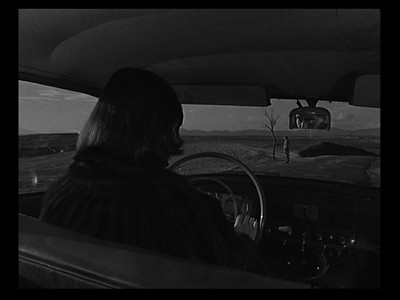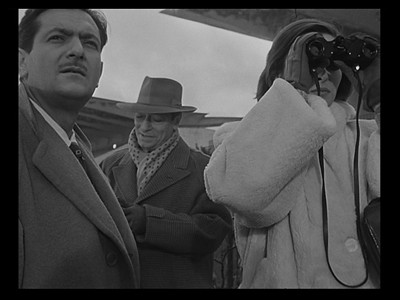
A bicyclist rides up an empty road in the evening. Just as he passes the horizon and disappears out of sight, there is a crash. A motorcar comes swerving into view and stops, its tires screeching. A man and a woman emerge and go to the downed biker. The man says the cyclist is still alive, but the woman, who was driving, urges him back into the car. They speed away, leaving the crash victim where he lay.
This is the opening of Juan Antonio Bardem's entertaining, suspenseful 1955 film Death of a Cyclist. There is no fuss, we are right in it.
As it turns out, the woman, Maria Jose (Lucia Bose), is married, and not to the man in the car. Juan (Alberto Closas) was her sweetheart before the war, but she married a rich man (Otello Toso) before he could return. Now they are lovers in secret, and helping the man they ran down would expose the adultery. This may not be that big of a deal for Juan, because he has nothing. Even his job as an assistant professor at the university was secured for him by his brother-in-law. Maria Jose, on the other hand, has plenty to lose. She enjoys her high-society existence, and even dares to suggest that it's her marriage that makes her affair with Juan possible. She doesn't say it outright, but the implication is clear: there is no romance in poverty.

Bardem's film is a little like a Spanish version of Renoir's Rules of the Game. Juan and Maria Jose are part of a class system that allows them to leave a man of lesser standing to die on the pavement. It's significant that the travelers are on the road going in two opposite directions, one in an expensive machine and the other on a simpler device. The bicyclist was likely returning home from work, and Maria was in a hurry so that she would not be late for her own dinner party. The division could not be more clear.
Really, the entire film is about divisions. Though the story is a rather standard murder plot, Bardem is using the pair's act of callous disregard as an excuse to extend a larger social critique. Lines are drawn in multiple instances to show the gulf between the common people and Spain's upper crust. The overcrowded tenement where the dead man lived is nothing like the large houses where his killers reside. Juan's lack of success is in stark contrast to his brother-in-law and Maria Jose's husband, Miguel. There is also a marked difference between the young and the old, between Juan and his students, particularly Matilde (Bruna Corra). Matilde has the misfortune of giving her oral exam when Juan sees the report of the hit-and-run in the newspaper, and instead of acknowledging that her assignment was halted by his own panic and not anything she did wrong, he flunks her. Her quiet crusade to achieve some kind of redress ends up being the catalyst for Juan's moral transformation. He is reminded of his own youthful fire before the war destroyed all of his beliefs. He is inspired not just by the passion Matilde evokes in her fellow students, but also by the compassion she shows him. Even though she is the one who has been wronged, she intuits that there is some kind of turmoil in Juan and would just as soon see it resolved as have her rightful grade restored.

From a filmmaking standpoint, Bardem and editor Margarita Ochoa show the criss-crossing interests through innovative and clever cutting. Virtuoso scenes of juxtaposed action push the story forward. This is most effective in the back-and-forth jumps between Juan's lonely torment at his mother's home and Maria Jose's attempts to cover her guilt amongst their society friends, including Juan's sister and her husband. Bardem jumps from the blowhard brother-in-law pontificating at Maria Jose's party to Juan watching a similar grandstand at a different party projected as part of a newsreel in a movie theatre, Isidro B. Maiztegui's melodramatic music ironically underscoring the political puffery. This shows us further how divorced these wealthy citizens are from reality, that they could just as easily be concoctions for the movies as they are actual people.
That is just one of the many inventive cuts that Bardem stacks in a particularly dizzy montage. In one instance, Juan exhales cigarette smoke in his bedroom, and the film jumps to Maria Jose fanning smoke away from her face across town in her own bedroom. The exhalation she chokes on is her husband's, but the connection is fairly obvious. Bardem uses similar connectors throughout the film, sometimes to lace pieces together, sometimes to pull them apart. He's showing us the various levels of the hierarchy, while also exposing the inconsistencies.

The most active agent for pointing out the class differences is also the major agent for Death of a Cyclist's plot momentum. The piano-playing art critic Rafa (Carlos Casaravilla) saw Juan and Maria Jose on that road that day. His revelation is almost like one of Bardem's clever editing set-ups, but without the edit. When Maria Jose's asks him the name of the tune he is playing, he says, "Blackmail," and the proceeds to explain the story behind the song, about a man and a woman in a car on their way to somewhere they aren't supposed to be. Rafa gleefully toys with the pair, refusing to show his cards, taking pleasure in their torment. He sees himself as the man in the middle, a lower-class citizen who is tolerated by the fancy crowd because he is entertaining. Now they can entertain him. It's an act of class revenge, but Rafa's own bid for social standing lacks the purity of a real revolution, and so he risks being a failed villain rather than a righteous crusader.
Without Rafa, however, Juan and Maria Jose would not be put on their opposing paths for dealing with the murder. While Juan seeks out what the police and the rest of the world knows about what happened, Maria Jose only cares about what Rafa knows. This means that Juan becomes concerned with how his actions affect those around them, be it the cyclist's widow or students like Matilde, while Maria Jose is only concerned with how it affects her. It becomes clear to Juan that he can't continue on as he has been going, that he must take responsibility for his choices, he is not above the law. He realizes that the supposed nobility lacks any real nobility, that these divides we have been seeing are unfair. The question is whether or not he can make Maria Jose have a similar moral awakening.

Despite the socially conscious underpinnings, Bardem's film is no more a message picture than Renoir's was. Its surface trappings are that of a thriller: who knows what, and what lengths will the guilty go to in order to stop that information from coming to light. As far as the tone and pacing of the film is concerned, Bardem also creates a division through technique. The scenes that directly relate to the killing are feverish, with Bardem employing his quick cuts and never lingering too long on one scene. Death of a Cyclist only stops to breathe when Matilde is on the screen, shifting gears from being a race against the clock to being a picture about moral issues. Though I wouldn't classify Death of a Cyclist as a film noir, there are hints of noir tropes in this dichotomy. Maria Jose, the brunette, would be the femme fatale in a Hollywood noir, while the lighter-haired Matilde is the noble and pure woman who sees redemption for the male heavy. Were this, say, Out of the Past
Ah, if only it were that simple. If Juan was up on his noir conventions, he'd know that the past always catches up with you, that the bad guys the hero wronged will always find the farm he's hiding out on. Bardem sees the difference between a moral victory and true change, and thus Death of a Cyclist ends where it began, on the same patch of road where the crime took place. The question that remains is if Juan's newfound conscience has enough cosmic influence to mean justice will be served. If we are truly on the symbolic flipside, then it will be poetic justice, and I must say, there's certainly nothing wrong with that.

Death of a Cyclist has one of the best photographic covers I have seen in a good long while. The choice of the right still from the movie can have a lot of impact (no pun intended), and the single image used as the front of this package is intriguing, showing us the basic set-up without saying too much. The well-placed logo and the decision to use a fractured font add to the sense of urgency while also suggesting danger. The art team at Criterion take it even a step further, and when you open the case, the image on the top of the disc is sequentially only a few more frames ahead of the cover still--Juan has reached the cyclist--and like two comic book panels, it creates the illusion of motion even before the DVD is inserted into the player.
Also smartly chosen is the DVD's sole video extra, the 2005 documentary Calle Bardem. The 40-minute feature gathers Bardem's friends and collaborators to share their experiences with and impressions of the late director. What emerges is a portrait of a filmmaker who walked it as he talked it. A lifelong member of the Communist Party, Bardem sought to fuse his love of Hollywood with a more socially conscious cinema based on the Italian Neorealist example, a synthesis that is on display in Death of a Cyclist. (The accompanying booklet also has Bardem's 1955 cinema manifesto, which explains his ideas further.) What ends up being interesting is how this dichotomy also informed Bardem's personal life. He was known alternately as a fun, compassionate individual and a dogmatic tyrant, an entertainer and a teacher.

You can't just walk away. Particularly when the future is rushing in the opposite direction.

No comments:
Post a Comment